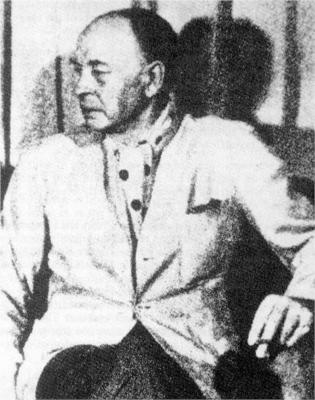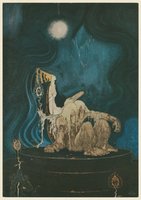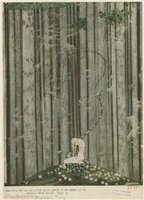Kay Nielsen
 Born in Copenhagen, Denmark, in 1886, Kay Rasmus Nielsen described being raised in a “tense atmosphere of art.”
Born in Copenhagen, Denmark, in 1886, Kay Rasmus Nielsen described being raised in a “tense atmosphere of art.”
While a student of painting, Nielsen also devoted himself to illustration, creating stark black-and-white compositions in pen and ink, related to contemporary literature or inspired by personal experience. This dramatic body of work elicited an invitation in 1910 to exhibit his work at Dowdeswell & Dowdeswells Ltd. Nielsen moved to London where his first exhibition in 1912 included the notable but unpublished series The Book of Death, a sequence of ten illustrations meditating on Pierrot devastated by the death of his beloved. In contrast to many of his contemporaries, Nielsen often focused on the melancholic or macabre elements of tales, and created visual sequences with themes of love, sexuality, loss and death.
Residing in Denmark, Nielsen continued to work on illustration commissions for English publishers. In 1924, Nielsen’s illustrations—admired for their watery blue palette, and their delicate floral borders inspired by Persian or Indian miniatures—appeared in a new edition of Fairy Tales by Hans Andersen, some of which he had been working on since his student days in Paris. This was followed by Hansel and Gretel and Other Stories by the Brothers Grimm in 1925, notable for its bold imagery. Five years later, Red Magic: A Collection of the World’s Best Fairy Tales from All Countries, edited by Romer Wilson, appeared. With his multi-cultural approach to illustration, Nielsen was suited to this type of anthology of global storytelling. However, due to the relatively poor quality of the publication and its small format, Nielsen’s creative efforts and stylistic range were not represented to best advantage in reproduction, as evidenced by the strength of the original illustrations that match his earlier work in technique and creative range.
In 1936 Nielsen went to California to collaborate with his actor friend and colleague Johannes Poulsen (1881-1938) on the stage sets and costumes for a large-scale theatrical production of Everyman at the Hollywood Bowl. With some tentative prospects for new professional opportunities in both theater and illustration, Nielsen remained in the United States with his wife Ulla, and found employment for a few years with Disney’s animation studio. Nielsen left an enduring visual legacy with the Night on Bald Mountain and Ave Maria segments of the 1940 animation film Fantasia. Although not produced in his lifetime, Nielsen’s conceptual contributions to Disney’s The Little Mermaid were credited at its release in 1989.
An internationally celebrated artist in his youth, Nielsen found minimal commercial success in the last decades of his life, eking out an existence with Ulla, between Denmark and California, with the support of a small group of devoted friends. In the years prior to his death in 1957, although plagued by poor health, Nielsen completed a handful of public painting commissions, including the school mural The First Spring, a monumental reflection of his artistic abilities as both stage designer and illustrator.
-- from the Society of Illustrators


